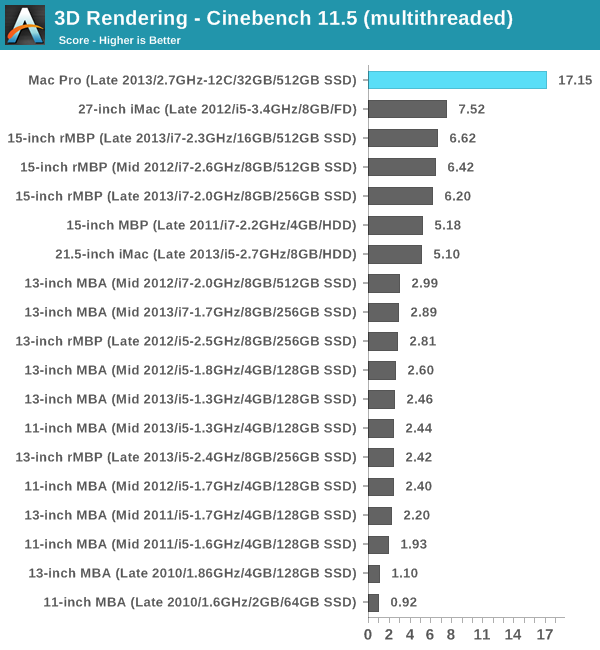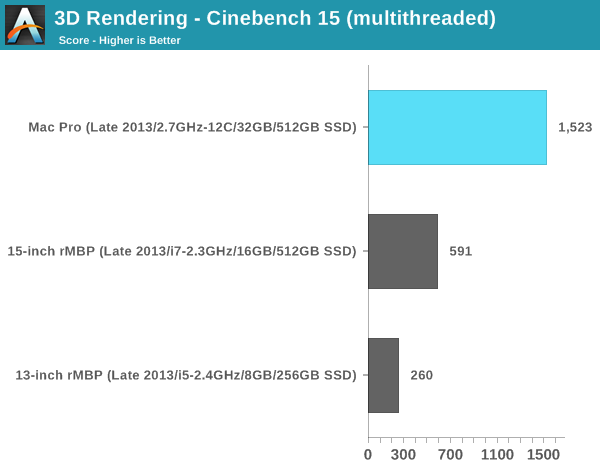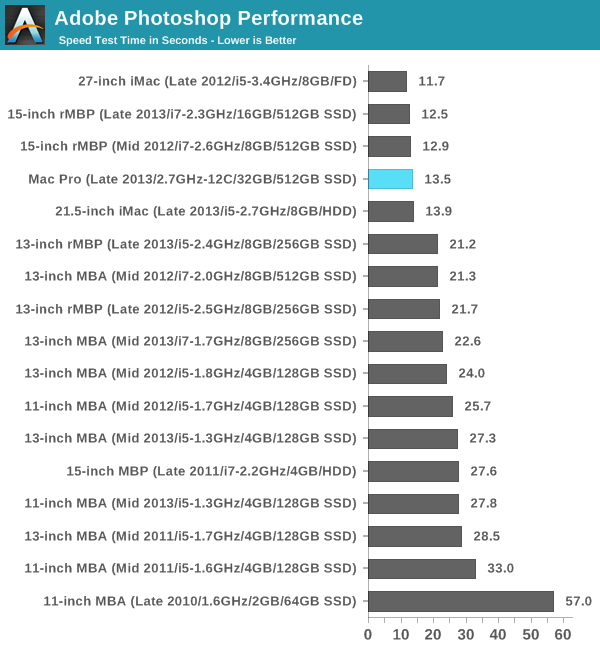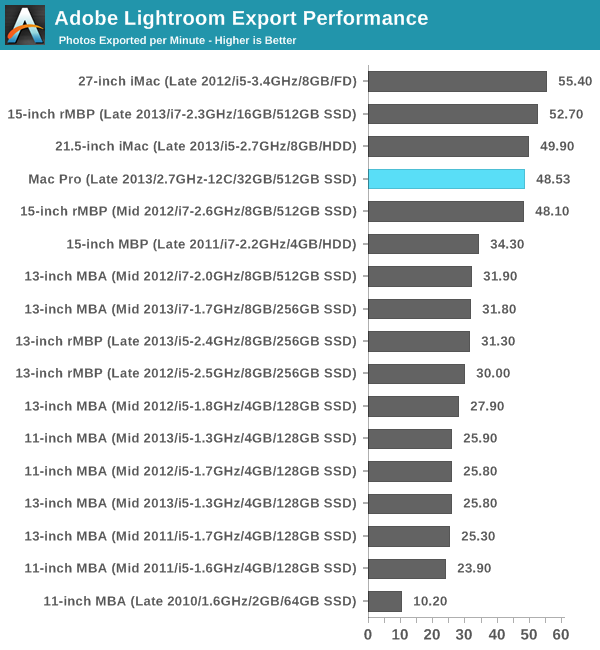The Mac Pro Review (Late 2013)
by Anand Lal Shimpi on December 31, 2013 3:18 PM ESTMac Pro vs. Consumer Macs
For my final set of CPU performance charts I put the new Mac Pro through the same set of tests I do all new Macs. There are definitely multithreaded components to these tests (some are indeed highly threaded), but the suite also values good single threaded performance. Here we'll get an idea of how the new Mac Pro, in its most expensive configuration, fares as a normal Mac.
I've already gone through Cinebench 11.5 results, but the following graphs should put in perspective the Mac Pro's performance relative to all consumer Macs:

If there's one graph that tells the story of why Intel's workstation roadmap is ridiculous, it's this one. The Mac Pro follows Intel's workstation roadmap, which ends up being cut down versions of Intel's server silicon, which happens to be a generation behind what you can get on the desktop. So while the latest iMac and MacBook Pro ship with Intel's latest Haswell cores, the Mac Pro uses what those machines had a year ago: Ivy Bridge. Granted everything else around the CPU cores is beefed up (there's more cache, many more PCIe lanes, etc...), but single threaded performance does suffer as a result.
Now part of this is exaggerated by the fact that I'm reviewing the 2.7GHz 12-core Mac Pro configuration. Single core turbo tops out at 3.5GHz vs. 3.9GHz for the rest of the parts. I suspect if you had one of the 8-core models you'd see peak single threaded performance similar to what the 2012 27-inch iMac delivers. The 2013 27-inch iMac with its fastest CPU should still be quicker though. We're not talking about huge margins of victory here, a matter of a handful of percent, but as a much more expensive machine it's frustrating to not see huge performance leadership in all areas.
The Mac Pro is designed to offer competitive single threaded performance, but really deliver for everyone who depends on great multithreaded performance:

If you need more cores, the Mac Pro is literally the only solution Apple offers that can deliver. We're talking about multiple times the performance offered by anything else in Apple's lineup with a Pro suffix.
I'm slowly but surely amassing Cinebench 15 results. The story doesn't really change here, I just thought I'd publish the numbers in case anyone wants data using this new test:


The latest versions of iPhoto and iMovie break comparisons to my older benchmarks so I've had to drop them here. I still have our Photoshop CS5 and Lightroom 3 tests though:

As I mentioned earlier, threading seems to have improved on newer versions of Photoshop. In CS5 our benchmark looks more like a lightly threaded test by comparison. Out of curiosity I ran the test under Photoshop CS6 and came away with a completion time of around 6 seconds.

Our Lightroom 3 export test tells a very similar story. Anyone with lighter workloads looking for a huge performance increase thanks to the Mac Pro will have to look elsewhere. The Mac Pro is at least performance competitive, but in these lightly threaded workloads you won't see a huge uplift.










267 Comments
View All Comments
Ppietra - Friday, January 3, 2014 - link
An object with black color only implies that it absorbs visible light. Thermal radiation is mostly infrared not visible light, so being black has no consequence since there is nothing emitting visible radiation internally. Externally the surface is very reflective so no problem there either - not that there would be one it wasn’t reflectivecosmotic - Tuesday, December 31, 2013 - link
It would be nice to see storage performance of the Mac Pro SSD against RAID on mechanical disks and SSD disks from a previous Mac Pro model.cosmotic - Tuesday, December 31, 2013 - link
Including IOPSacrown - Tuesday, December 31, 2013 - link
The early 2008 Mac Pro does not support hyperthreadimg as your charts indicate. Of course I could just be doing something wrong with mine...acrown - Tuesday, December 31, 2013 - link
Stupid onscreen keyboard. I meant hyperthreading of course.Anand Lal Shimpi - Tuesday, December 31, 2013 - link
Whoops, you're right! Fixed :)acrown - Tuesday, December 31, 2013 - link
Great article by the way. I'm so on the fence about whether to get one to replace my current Mac Pro.The read is tempting me more and more though...
ananduser - Tuesday, December 31, 2013 - link
It's actually simple, it's the best OSX workstation for seemingly only Apple software that actually makes full use of the GPU setup.If your workflow revolves exclusively around FCX, it is the only workstation you'll need. If you're an average consumer wanting a powerful OSX machine you'd better get a consumer oriented imac.
PS: No need for me to mention that if you'll need CUDA and Windows then it's a bad buy.
akdj - Wednesday, January 1, 2014 - link
I'd expect OpenCL to become more and more and MORE ubiquitous as time marches on and Moore's law in relation to CPU slows...and more computing can be taken care of via screaming fast GPUs. Again. Early adopters. But CUDA/Windows options are aplenty. Just more expensive and without twin GPUs. Without PCIe storage. And.....oh yeah, their Windows boxes. At least with the MP you can run Windows...and perhaps, as we saw Adobe so quickly do with HiDPI support post rMBP release (along with hundreds of other apps and software companies)---hopefully Windows 8.2/9.x realizes the more significant 'all around' gains utilizing OpenCL (nVidia too?) than the very, VERY select software titles that take advantage of CUDA....and when they do, it's primal in comparison to what OpenCL opens the doors for. Literally. Everythingmoppop - Wednesday, January 1, 2014 - link
Considering CUDA is a GPGPU API there's no door that OpenCL opens that CUDA can't do...in fact, you could say that CUDA opens more doors on an Nvidia GPU. Nvidia also supports OpenCL since it was among the parties to help expand the api spec, but make no mistake, their flagship is CUDA.Aside from shunning Nvidia to market-segments whose software will be at least CUDA-accelerated (if there's GPU accelaration at all), my main beef with the Mac Pro, however, is that there are artificial limits placed by the design. Namely 1 CPU socket and only 4 DIMM slots.
For VFX/3DCG pros, the reality is that GPU rendering simply isn't there yet. Your PRMan, Mental Ray, V-Ray (not real-time V-Ray), Arnold, and Mantra renderers are still very much in the CPU world. When professionals buy a machine they need it to work now, and not 5 years from now. While the Mac Pro certainly appeals to portions of the pro market-segment, it was a simply foolish reason to castrate the Mac Pro.